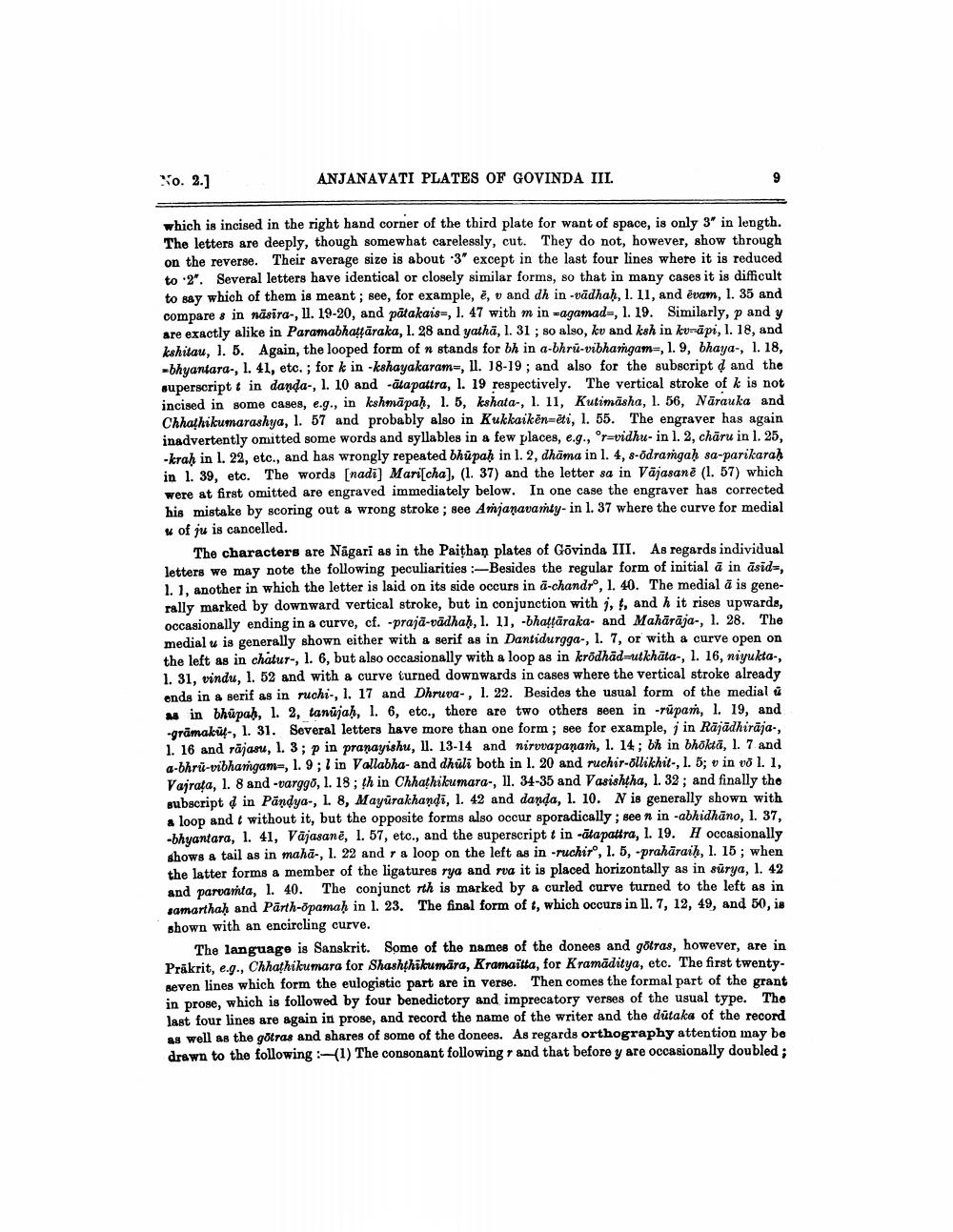________________
No. 2.]
ANJANAVATI PLATES OF GOVINDA III.
9
which is incised in the right hand corner of the third plate for want of space, is only 3" in length. The letters are deeply, though somewhat carelessly, cut. They do not, however, show through on the reverse. Their average size is about 3" except in the last four lines where it is reduced to 2". Several letters have identical or closely similar forms, so that in many cases it is difficult to say which of them is meant; see, for example, è, v and dh in -vadhaḥ, 1. 11, and evam, 1. 35 and compare 8 in nasira-, 11. 19-20, and patakais, 1. 47 with m in -agamad-, 1. 19. Similarly, p and y are exactly alike in Paramabhaṭṭāraka, 1. 28 and yatha, 1. 31; so also, ku and ksh in kv-äpi, 1. 18, and kshitau, 1. 5. Again, the looped form of n stands for bh in a-bhru-vibhamgam-, 1. 9, bhaya-, 1. 18, -bhyantara-, 1. 41, etc. ; for k in -kshayakaram, l. 18-19; and also for the subscript d and the superscript t in danda-, 1. 10 and -atapattra, 1. 19 respectively. The vertical stroke of k is not incised in some cases, e.g., in kshmäpaḥ, 1. 5, kshata-, 1. 11, Kutimasha, 1. 56, Narauka and Chhathikumarashya, 1. 57 and probably also in Kukkaiken-eti, 1. 55. The engraver has again inadvertently omitted some words and syllables in a few places, e.g., °r-vidhu- in 1. 2, chāru in 1. 25, -krah in 1. 22, etc., and has wrongly repeated bhupaḥ in 1. 2, dhama in l. 4, s-odramgaḥ sa-parikaraḥ in 1. 39, etc. The words [nadi] Mari[cha], (1. 37) and the letter sa in Vajasane (1. 57) which were at first omitted are engraved immediately below. In one case the engraver has corrected his mistake by scoring out a wrong stroke; see Amjanavamty- in 1. 37 where the curve for medial u of ju is cancelled.
The characters are Nagari as in the Paithan plates of Govinda III. As regards individual letters we may note the following peculiarities :-Besides the regular form of initial a in asid=, 1. 1, another in which the letter is laid on its side occurs in a-chandr°, 1. 40. The medial a is generally marked by downward vertical stroke, but in conjunction with j, f, and h it rises upwards, occasionally ending in a curve, cf. -praja-vädhaḥ, 1. 11, -bhattaraka- and Mahārāja-, 1. 28. The medial u is generally shown either with a serif as in Dantidurgga-, 1. 7, or with a curve open on the left as in chatur-, 1. 6, but also occasionally with a loop as in krödhäd-utkhata-, 1. 16, niyukta-, 1. 31, vindu, 1. 52 and with a curve turned downwards in cases where the vertical stroke already ends in a serif as in ruchi-, 1. 17 and Dhruva-, 1. 22. Besides the usual form of the medial u as in bhupaḥ, 1. 2, tanujaḥ, 1. 6, etc., there are two others seen in rupam, 1. 19, and -grāmakuf-, 1. 31. Several letters have more than one form; see for example, j in Rājādhirāja-, 1. 16 and rajasu, 1. 3; p in pranayishu, 11. 13-14 and nirvvapanam, 1. 14; bh in bhōktā, 1. 7 and a-bhru-vibhamgam-, 1. 9; 1 in Vallabha- and dhuli both in 1. 20 and ruchir-öllikhit-, 1. 5; v in vō 1. 1, Vajrata, 1. 8 and -varggo, 1. 18; th in Chhathikumara-, 11. 34-35 and Vasishtha, 1. 32; and finally the subscript d in Pandya-, 1. 8, Mayurakhandi, 1. 42 and danda, 1. 10. N is generally shown with a loop and without it, but the opposite forms also occur sporadically; see n in -abhidhāno, 1. 37, -bhyantara, 1. 41, Vajasaně, 1. 57, etc., and the superscript t in -atapattra, 1. 19. H occasionally shows a tail as in mahā-, 1. 22 and r a loop on the left as in -ruchir°, 1. 5, -prahāraiḥ, 1. 15; when the latter forms a member of the ligatures rya and rea it is placed horizontally as in surya, 1. 42 and parvamta, 1. 40. The conjunct rth is marked by a curled curve turned to the left as in samarthaḥ and Parth-opamaḥ in 1. 23. The final form of t, which occurs in 11. 7, 12, 49, and 50, is shown with an encircling curve.
The language is Sanskrit. Some of the names of the donees and götras, however, are in Prakrit, e.g., Chhathikumara for Shashthikumāra, Kramaitta, for Kramaditya, etc. The first twentyseven lines which form the eulogistic part are in verse. Then comes the formal part of the grant in prose, which is followed by four benedictory and imprecatory verses of the usual type. The last four lines are again in prose, and record the name of the writer and the dutaka of the record as well as the gōtras and shares of some of the donees. As regards orthography attention may be drawn to the following:-(1) The consonant following r and that before y are occasionally doubled;




